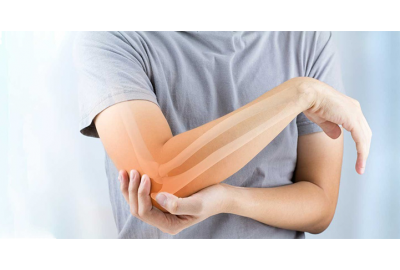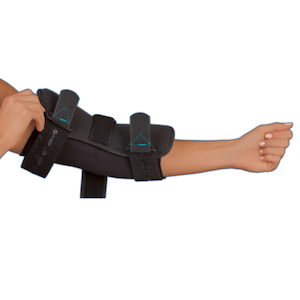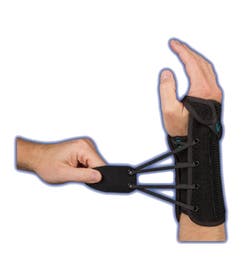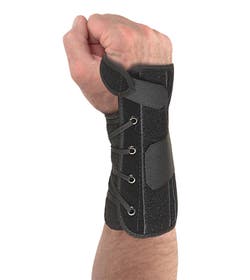Ulnar Neuropathy - Overview
Anatomy of the Ulnar Nerve
The Ulnar Nerve runs from the shoulder down to the pinky finger; providing motor movements in the forearm and hand, as well as sensation in the hand. When an individual hits their “funny bone” at the back of the elbow, the ulnar nerve is briefly compressed and produces a numbing, tingling sensation in the fifth (pinky) and fourth (ring) finger. This occurs because the ulnar nerve is close to the surface of the arm at this location, so it is more likely to be compressed or damaged.
What is Ulnar Neuropathy?
Unlike many other nerves, the ulnar nerve is not always protected by muscle or bone as it travels down the arm. As nerves travel throughout your body, they can pass through tight spaces where they are more likely to be compressed or damaged. This is the case for the ulnar nerve at the elbow (Cubital Tunnel Syndrome) and the wrist (Ulnar Tunnel Syndrome).
The term Ulnar Neuropathy simply means that there is damage to the ulnar nerve. This could occur from prolonged stretching of the nerve, excessive vibration, direct pressure, or if the nerve does not stay in its proper position and shifts across a boney surface which can cause irritation with repetition.
Symptoms of Ulnar Neuropathy:
- Loss of muscle mass
- Weakness and tenderness in the hand
- Tenderness at elbow joint
- Tingling in the palm, fourth (ring) and fifth (pinky) fingers


Function of the Ulnar Nerve:
- Flexion (bending movement) muscles of the forearm that allow for the wrist to flex
- Flexion movement of the pinky and ring finger
- Spreading of the pinky and ring finger
- Sends sensation feelings from the hand and fingers to the brain.
Ulnar Neuropathy can present itself as Cubital Tunnel Syndrome and Ulnar Tunnel Syndrome.
Braces and Supports for Cubital Tunnel Syndrome and Ulnar Tunnel Syndrome
What is Cubital Tunnel Syndrome?


Cubital Tunnel Syndrome is caused by compression of the ulnar nerve at the elbow as it runs through the cubital tunnel. This can be aggravated by repeated overuse (such as repeatedly lifting things), direct pressure (such as leaning the elbow against a solid surface), or prolonged stretching of the nerve. Individuals may note numbness or tingling in the fourth (ring) and fifth (pinky) finger when they wake up in the morning. This sensation can be a result of prolonged stretching of the nerve overnight if you are sleeping with your elbow bent and resting your head on your hand. A way to prevent this from occurring is to wear a splint at night that keeps the elbow at 120 degrees to prevent nerve compression at the elbow joint. Our first recommendation is the MedSpec Cubital Tunnel Brace as it is low profile and comfortable.
If you still have the compression of the ulnar nerve throughout the day, it could be a result of the direct pressure on the nerve. Our recommendation for a day-time option would be the DonJoy Spider Elbow pad as the added padding provides more protection for the ulnar nerve.
What is Ulnar Tunnel Syndrome?


Ulnar Tunnel Syndrome is caused by compression of the ulnar nerve at the wrist as it passes through the Guyon’s canal. Other names include Guyon’s Canal Syndrome, Cyclist Palsy or Handlebar Palsy. It can be caused by repetitive harsh movements (like hammering or excessive vibration), or constant pressure on the wrist (such as long periods of time leaning onto bicycle handlebars). This is most common in long distance cyclists. Symptoms present first as sensory changes like numbness or tingling in the 4th (ring) and 5th (pinky) finger, but can develop to muscle weakness and cramping over time. A wrist brace can help alleviate the pressure and decompress the nerve. Our top recommendation for Ulnar Tunnel Syndrome would be the MedSpec Wrist Lacer II as it is moisture wicking, anti-bacterial and keeps the wrist in a neutral position to reduce irritation of the ulnar nerve.


Reminder: Brace options will depend on where the compression of the nerve occurs. Don't forget to consult your physiotherapist or healthcare practitioner for more information on how to alleviate the pain and numbness. Together with physical therapy, a brace and the right exercises may be your best bet to overcoming Ulnar Neuropathy.
Browse our products to treat Cubital Tunnel and Ulnar Tunnel Syndrome















